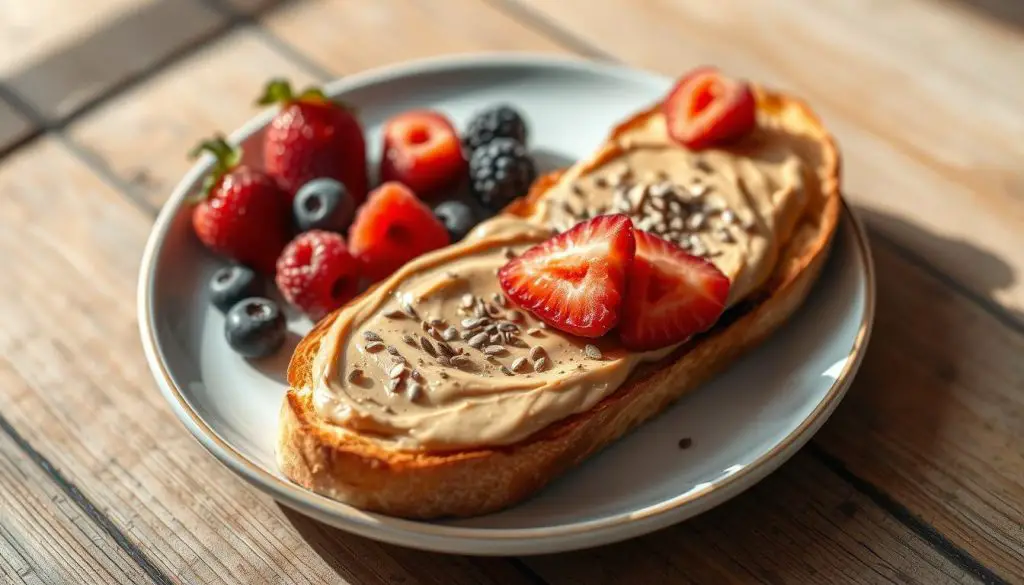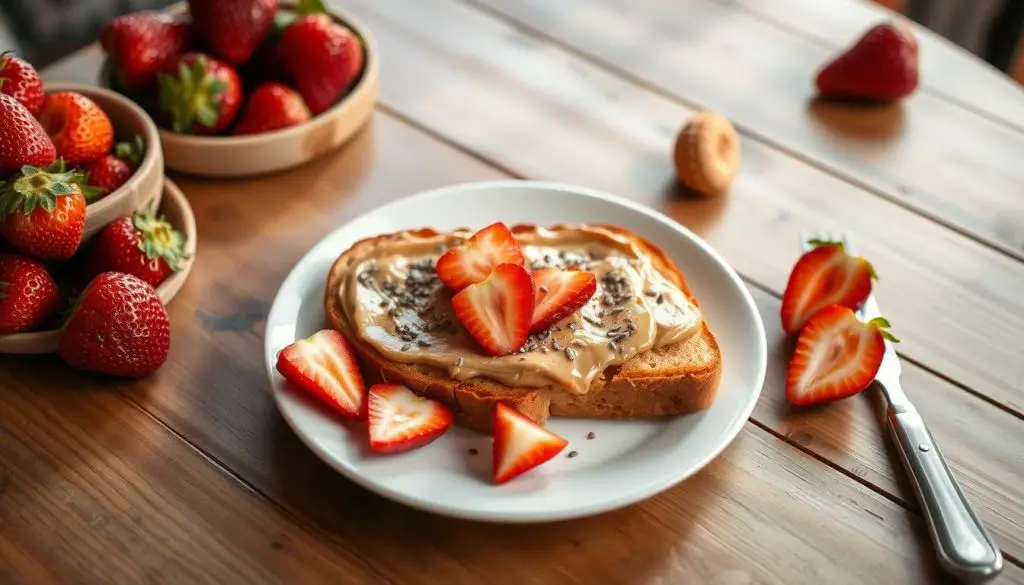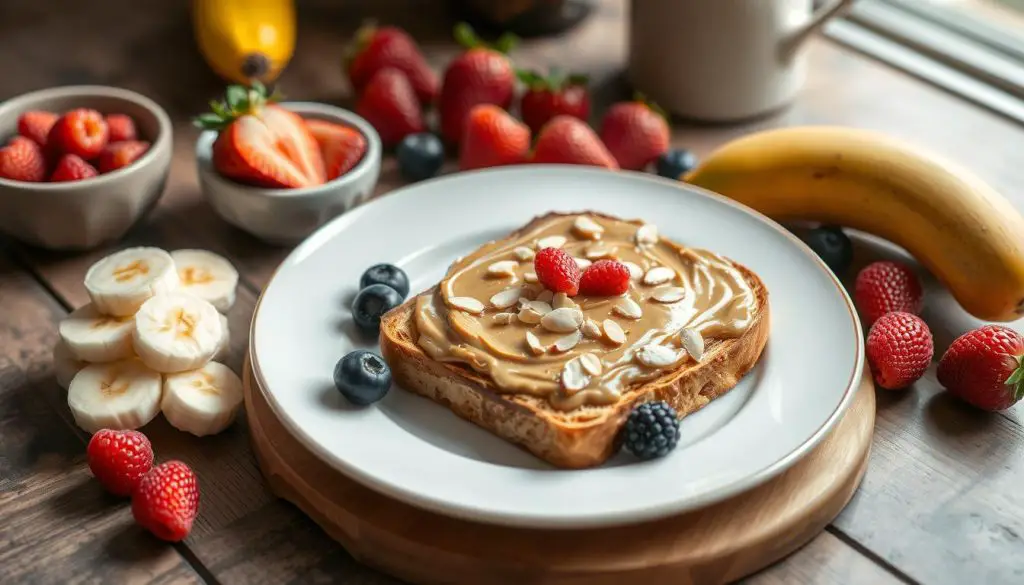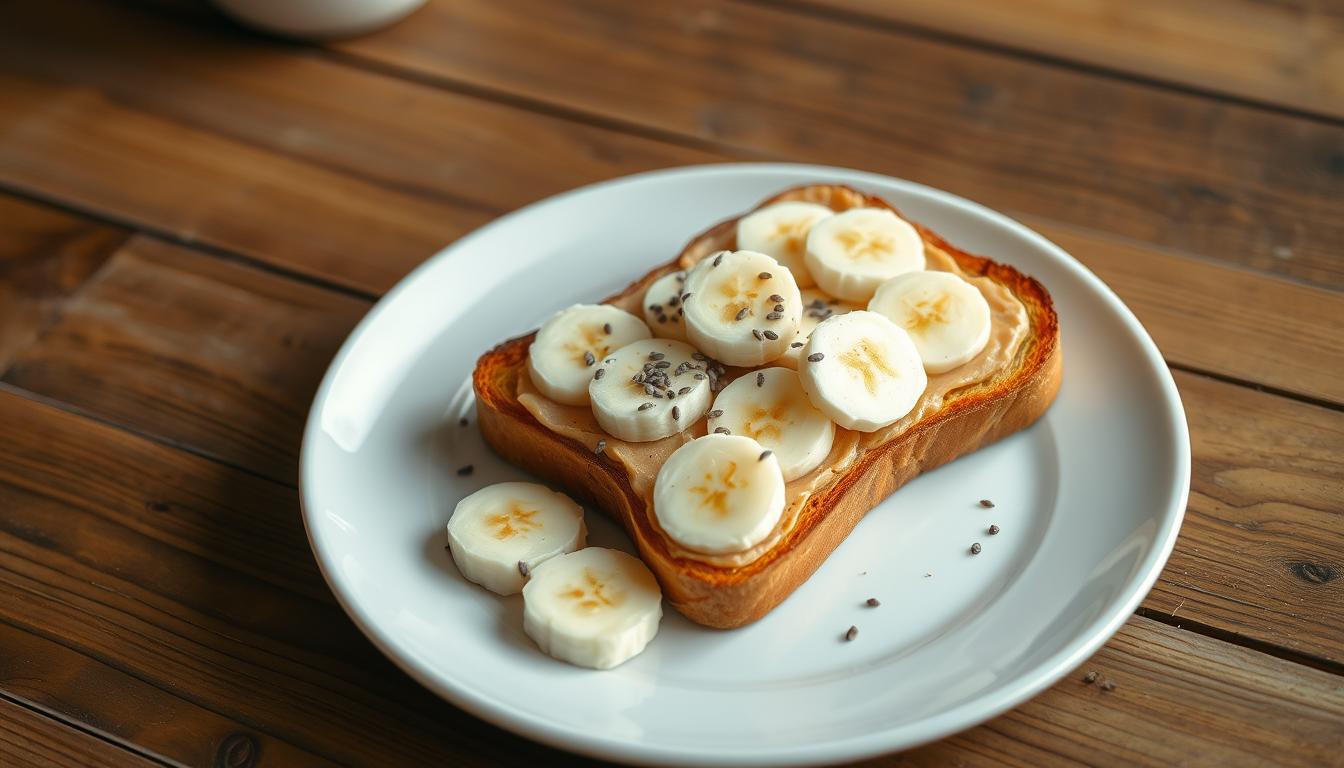Could a simple gluten-free breakfast help manage fibromyalgia’s chronic pain and fatigue? The answer might be in a slice of gluten-free toast with almond butter. Did you know 41% of people with celiac disease are vitamin B12 deficient? Vitamin B12 is key for energy and nerve health, often affected by fibromyalgia.
Explore how this easy breakfast can be a big part of a fibromyalgia-friendly diet. Almond butter has anti-inflammatory properties. A gluten-free diet is also vital for managing symptoms. This article will give you the recipe and insights to improve your health and find relief.
What is Fibromyalgia and How Diet Can Help
Understanding Fibromyalgia: A Chronic Pain Condition
Fibromyalgia is a long-term condition that causes widespread pain, tiredness, and trouble sleeping. It affects about 4 million adults in the United States. This condition can greatly reduce a person’s quality of life.
The Role of Diet in Managing Fibromyalgia Symptoms
Diet is key in managing fibromyalgia symptoms. It can help by reducing inflammation, improving sleep, and giving the body the nutrients it needs. Studies have found that some dietary changes can help lessen the condition’s effects.
- A 2019 review found that diet helped in five out of seven studies for fibromyalgia. It improved sleep, reduced depression and anxiety, and enhanced quality of life.
- A 2016 study showed that antioxidant-rich diets helped people with fibromyalgia. They had fewer tender points and better quality of life.
- In 2017, a study found that extra virgin olive oil reduced oxidative stress. It also improved physical and mental function in those with fibromyalgia.
By understanding fibromyalgia and the benefits of a good diet, people can actively manage their symptoms. This can lead to a better overall well-being.
Benefits of a Gluten-Free Diet for Fibromyalgia
Living with fibromyalgia can be tough. But, a gluten-free diet might help a lot. Gluten is in wheat, rye, and barley and can cause inflammation and stomach problems. By avoiding gluten, you might feel better and live better.
One big plus of a gluten-free diet is it can reduce inflammation. Fibromyalgia often leads to high inflammation levels. Cutting out gluten can lower these levels and ease pain and discomfort.
Also, a gluten-free diet can improve digestion for those with fibromyalgia. Many with this condition have digestive issues like bloating or diarrhea. By avoiding gluten, you might see better digestion and overall gut health, which can help with other symptoms too.
| Condition | Prevalence |
|---|---|
| Celiac disease | Affects at least 1% of the population in the Western world |
| Non-celiac gluten sensitivity (NCGS) | Believed to affect around 0.6%-13% of people |
| Gluten ataxia | Accounts for approximately 15% of all ataxia diagnoses |
| Wheat allergy in children | Approximately 65% outgrow it by the age of 12 years |
Not everyone with fibromyalgia will see benefits from a gluten-free diet. But, for those who do, it can greatly improve their life. Talk to your doctor to see if it’s right for you.
The Power of Almond Butter: A Nutritious Spread
Adding foods like almond butter to your diet can help with fibromyalgia. Almond butter is tasty and packed with nutrients. It’s great for people with this chronic condition.
Almond Butter: A Source of Healthy Fats and Protein
Almond butter is full of healthy fats and protein. These are key for staying healthy and managing fibromyalgia symptoms. The fats in almond butter can lower inflammation. The protein helps muscles recover and work better.
Eating almond butter regularly gives you lasting energy. It also keeps you feeling full. This is good for people with fibromyalgia.
Anti-Inflammatory Properties of Almond Butter
Almond butter also has anti-inflammatory properties. These can help with fibromyalgia symptoms. The fats in almond butter reduce body inflammation. This can ease chronic pain and muscle aches.
Many studies show the benefits of almond butter. It’s good for a fibromyalgia-friendly diet. You can put it on gluten-free toast, mix it into smoothies, or use it as a veggie dip. Almond butter is a nutritious and flexible choice for your health.
Gluten-free Toast with Almond Butter for Fibromyalgia
Your diet is key in managing fibromyalgia. It helps reduce pain and boosts well-being. A great breakfast choice is gluten-free toast with almond butter. This combo offers the benefits of a gluten-free diet and the anti-inflammatory effects of almond butter. It’s a nutritious start to your day and can ease symptoms.
People with celiac disease, wheat allergies, or non-celiac gluten sensitivity should eat gluten-free. Gluten-free bread or toast avoids wheat’s inflammatory effects. It makes sure your breakfast meets your dietary needs.
Almond butter is also beneficial for fibromyalgia management. It’s packed with healthy fats, protein, and antioxidants. Almond butter’s anti-inflammatory properties can help reduce inflammation and ease symptoms.
Choosing gluten-free toast with almond butter for breakfast is a smart move. It’s a delicious and healthy meal that supports your health. This simple breakfast is a great way to start your day with a fibromyalgia-friendly option.

Easy Gluten-Free Toast Recipe
Make homemade gluten-free toast with just a few simple ingredients. This gluten-free toast recipe is great for those with fibromyalgia. It’s easy to make and very tasty.
Ingredients and Instructions
To make this gluten-free toast recipe, you’ll need:
- 2 cups gluten-free flour blend
- 1 teaspoon baking powder
- 1/2 teaspoon sea salt
- 1/4 cup unsweetened almond milk
- 2 tablespoons olive oil
- 1 egg
Here’s how to prepare the gluten-free toast:
- Preheat your oven to 375°F (190°C).
- In a large bowl, whisk together the gluten-free flour blend, baking powder, and sea salt.
- In a separate bowl, mix the almond milk, olive oil, and egg. Whisk until smooth.
- Add the wet ingredients to the dry ingredients, mixing until a dough forms.
- Spread the dough on a baking sheet lined with parchment paper, into a rectangle about 1/2-inch thick.
- Bake for 20-25 minutes, or until it’s lightly golden and firm.
- Let the toast cool completely, then slice it to your liking.
This gluten-free toast recipe is easy to follow. It’s perfect for a delicious and nutritious breakfast or snack. Try it with almond butter for a tasty and fibromyalgia-friendly meal.
Topping Options: Almond Butter and More
Customizing your gluten-free toast with almond butter opens up a world of possibilities. The classic almond butter topping is tasty and healthy. But, there are many other options to boost your breakfast’s flavor and nutrition.
Sliced bananas are a great choice. They’re full of potassium and can ease digestion. Fresh berries, like blueberries or strawberries, add antioxidants and fiber.
For a crunchy touch, add chopped nuts or seeds. Walnuts, almonds, or chia seeds bring healthy fats, protein, and fiber. They keep you full and satisfied.
For a savory twist, try avocado slices. Avocados are rich in healthy fats. They help reduce inflammation and support your wellbeing.

Don’t be shy to get creative with your toppings! Add a drizzle of honey or maple syrup for sweetness. Sprinkle cinnamon or nutmeg for a warm, comforting flavor.
The secret to a great gluten-free toast with almond butter is to try different healthy toppings. Find what you like and what fits your diet. Enjoy making your breakfast special!
Nutritional Value of Gluten-Free Toast with Almond Butter
Managing fibromyalgia involves what you eat. Gluten-free toast and almond butter are great choices. They offer many nutritional benefits for those with this condition.
Gluten-free toast, from grains like brown rice or oats, is good for fibromyalgia. It has complex carbs that keep blood sugar stable. This helps manage energy and reduce inflammation.
Almond butter is packed with healthy fats, protein, and vitamins. It has anti-inflammatory properties that ease fibromyalgia pain and stiffness.
The mix of gluten-free toast and almond butter is a balanced and fibromyalgia-friendly option. It supports health and well-being. This combo is key to managing fibromyalgia symptoms.
Nutritional Breakdown of Gluten-Free Toast with Almond Butter
This combo offers many essential nutrients:
- Complex carbs for lasting energy
- Healthy fats for heart health and less inflammation
- Protein for muscle recovery and upkeep
- Fiber for better digestion
- Vitamins and minerals like vitamin E and magnesium for overall health
Adding this nutritious and fibromyalgia-friendly mix to your diet can nourish your body. It may also help ease some symptoms of this chronic condition.
Incorporating Gluten-Free Toast with Almond Butter into a Fibromyalgia Diet
Managing fibromyalgia means eating a balanced diet. Adding gluten-free toast with almond butter to your meals is a tasty way to do this. It’s packed with nutrients that help your body stay healthy.
This breakfast is full of healthy fats, protein, and complex carbs. These nutrients help keep your blood sugar stable, give you energy, and fight inflammation. All are key for fibromyalgia patients.
Pair this toast with almond butter with other healthy foods. Think fresh fruits, veggies, lean proteins, and whole grains. This mix ensures you get all the nutrients you need for good health.
Don’t forget about portion sizes. While the toast with almond butter is good for you, eat it in moderation. Talk to your doctor or a dietitian to find the right amount for you.
Adding this toast to your diet can make breakfast both tasty and beneficial. It may help manage your symptoms and improve your health. Always pay attention to how your body reacts and adjust your diet as needed.

Tips for Making Gluten-Free Toast with Almond Butter
Enjoying gluten-free toast with almond butter is a great way to add nutrition to your diet. Here are some tips to make your gluten-free toast experience a success:
- Choose the right gluten-free bread: Pick gluten-free bread made with ingredients like almond flour, rice flour, or quinoa. These give better texture and taste than processed gluten-free breads.
- Properly store the almond butter: Keep almond butter fresh by storing it in a cool, dry place. Avoid direct sunlight. Refrigeration can also help it last longer.
- Reheat the toast with care: When reheating, don’t over-toast or burn the bread. This can ruin its texture and taste. Warm it gently in the oven or toaster oven to keep it soft and crispy.
By following these tips, your gluten-free toast with almond butter will be a delightful part of your meals. Enjoy the perfect mix of crispy toast and creamy almond butter.
Gluten-Free Diet and Fibromyalgia: A Holistic Approach
Managing fibromyalgia requires a holistic approach that includes many lifestyle changes. The gluten-free toast with almond butter recipe is a tasty and healthy choice. But it’s just one part of a bigger plan to tackle this chronic pain condition.
Studies suggest that a gluten-free diet may help those with. Over 500 people on Udi’s Facebook page shared their health struggles, including fibromyalgia. Many said they felt better after cutting gluten from their diets.
A holistic approach to fibromyalgia isn’t just about food. It also includes:
- Regular exercise to improve physical function and reduce pain
- Stress management techniques, such as meditation, yoga, or deep breathing, to address the mental and emotional aspects of the condition
- Incorporating complementary therapies, like acupuncture or massage, to provide additional pain relief and support overall well-being
By tackling fibromyalgia from all angles, people can manage their symptoms better. The gluten-free toast with almond butter is a tasty and healthy part of this plan. It offers a satisfying and anti-inflammatory meal option.

Fibromyalgia affects more women than men, with about 6 percent of women in the general population having it. Conditions like Chronic Fatigue Syndrome/Myalgic Encephalomyelitis (CFS/ME) also affect around 3 percent of women. This highlights the need to explore many strategies, including dietary changes, to manage these complex conditions effectively.
Fibromyalgia-Friendly Snack Ideas
Finding the right snacks with fibromyalgia can be tough. But, with a bit of creativity, you can enjoy healthy and tasty snacks. Here are some ideas to help you:
- Nut butters, like almond butter, with gluten-free crackers or apple slices for a crunchy snack
- Chickpea-based snacks, like roasted chickpeas or hummus with avocado and aquafaba, to fight inflammation
- Energy bars made with dates for a quick protein and fiber boost
- Greek yogurt bark with fresh berries and dark chocolate chips for a healthy dessert
- Peanut butter and chocolate energy balls for a mix of carbs
Adding these snacks to your diet can help manage symptoms and improve your health. The goal is to find snacks that are nutritious, easy to make, and fit your needs.
| Snack Idea | Potential Benefits |
|---|---|
| Beet jerky | Provides a savory and chewy vegan snack alternative |
| Rice cake with almond butter and sliced apple | Offers a fiber and protein-rich snack option |
| Beet hummus with veggie chips or pita chips | Flavorful dip that can help reduce inflammation |
By adding these snacks to your diet, you can better manage your symptoms and improve your health. Always talk to your healthcare provider to find the best diet for you.
Gluten-free Toast with Almond Butter: A Tasty and Nutritious Option
Living with fibromyalgia can make finding good food tough. But, gluten-free toast with almond butter is a tasty and healthy choice. It meets your dietary needs and boosts your health.
Research links gluten intolerance to fibromyalgia symptoms like pain and fatigue. A gluten-free diet might help lessen these symptoms. This means you can manage your condition better and live a fuller life. The gluten-free toast with almond butter is not just delicious but also helps fight inflammation.
Almond butter is full of healthy fats, protein, and anti-inflammatory compounds. Adding it to your gluten-free toast gives your body vital nutrients. It can help reduce inflammation and improve your overall health. Starting your day with this meal can also boost your mental clarity and energy, making it easier to face fibromyalgia’s challenges.
Source Links
- https://www.healthline.com/nutrition/gluten-free-snacks
- https://www.eatingwell.com/article/7866119/rheumatoid-arthritis-diet-plan/
- https://www.verywellhealth.com/fibromyalgia-diet-good-and-bad-foods-4144693
- https://www.medicinenet.com/what_foods_trigger_fibromyalgia_pain/article.htm
- https://artoflifeandwellness.wordpress.com/2015/09/04/my-top-7-foods-for-fibromyalgia/
- https://www.healthline.com/nutrition/gluten-free-diet
- https://www.everydayhealth.com/diet-nutrition/gluten-free-diet/
- https://www.fibro.org/voices-of-fibrostories/get-on-board-go-plant-based-for-fibromyalgia-healing
- https://www.living-smarter-with-fibromyalgia.com/gluten-free.html
- https://www.chantalhoeysanders.com/chpt-2-controlling-symptoms-with-fo
- https://www.healthline.com/nutrition/gluten-food-list
- https://www.everydayhealth.com/fibromyalgia/diet/fibromyalgia-what-eat-what-avoid/
- https://www.nutritionandhealthworks.com/post/don-t-worry-that-it-tastes-good-it-is-gluten-free-3-easy-to-make-gluten-free-breads
- https://www.nutritionandhealthworks.com/post/make-it-monday-3-ingredient-gluten-free-bread
- https://universityhealthnews.com/daily/pain/fibromyalgia-diet-may-help-control-pain/
- https://www.silversneakers.com/blog/3-new-twists-on-your-favorite-healthy-foods/
- https://www.ibsclinics.co.uk/what-to-eat-for-breakfast-with-ibs-flare-up/
- https://www.drtereo.com/blog/sample-menu-
- https://medium.com/@amandakimberleylb/the-fibro-and-gluten-free-journey-79130d350b8b
- https://www.healthline.com/nutrition/mind-diet
- https://sevenlayercharlotte.com/2018/06/10/gluten-free-q/
- https://www.painscale.com/article/tips-for-a-gluten-free-diet
- https://glutendude.com/why-do-people-go-gluten-free/
- http://ndl.ethernet.edu.et/bitstream/123456789/36842/1/3125.pdf
- https://www.eatingwell.com/gallery/7963958/anti-inflammatory-snack-recipes/
- https://drruscio.com/low-fodmap-snacks/
- https://www.healthline.com/nutrition/grain-free-diet
- https://surefoodsliving.com/2008/11/fibromyalgia-chronic-fatigue-and-gluten-intolerance/comment-page-4/
- https://www.dandelionnutrition.com/niblets-blog
